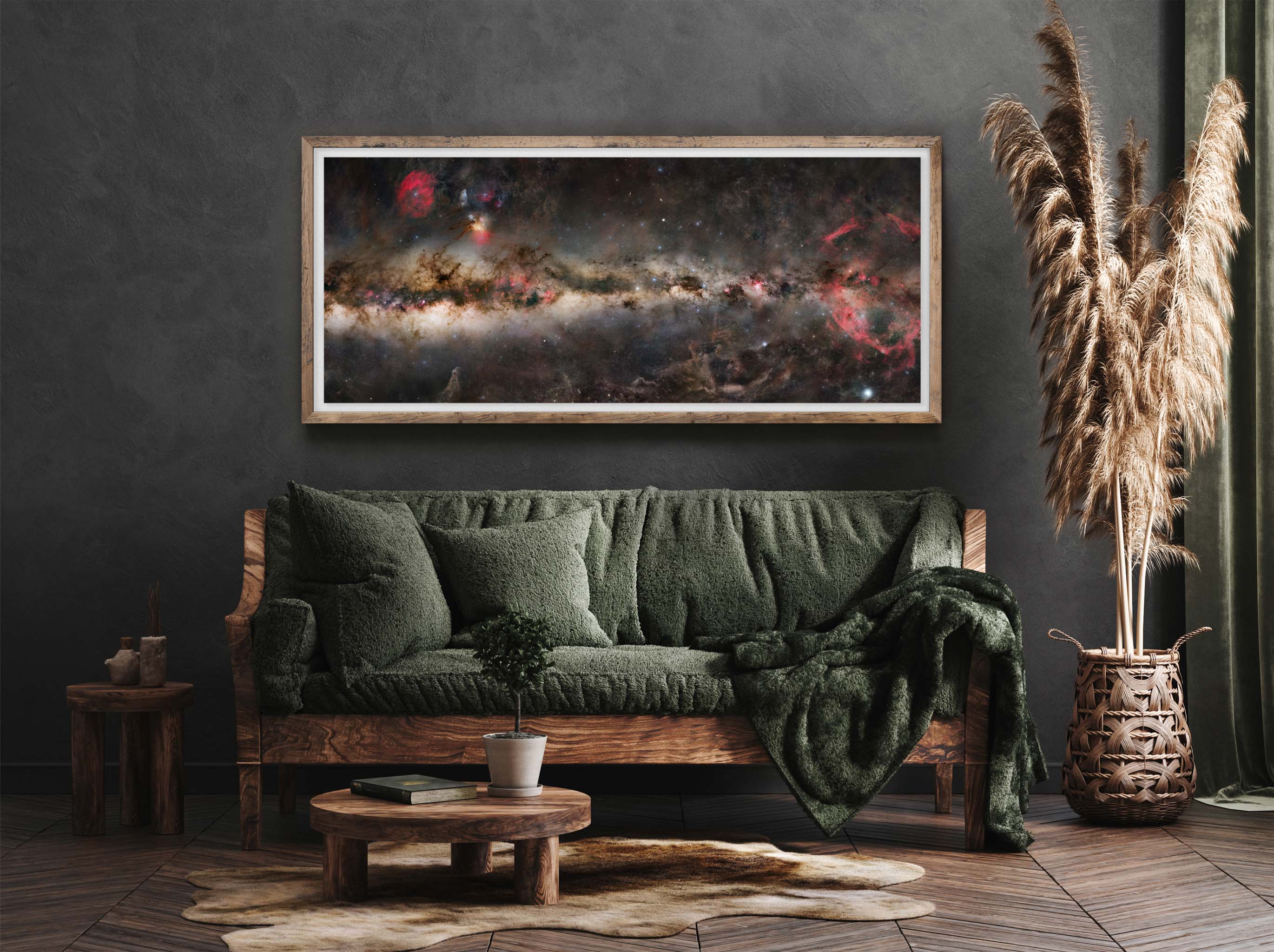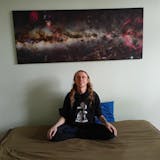Probably everybody has heard the term „Milky Way” but only around 30% of the population live in places that allow us to see the Milky Way in the night sky. The rest of the people will never see the Milky Way in their lives due to increasing light pollution. What if one could not only gaze at one of the darkest skies on Earth but also take advantage of it to gather the photons from our cosmic city the Milky Way for dozens of hours? This image is the answer. Below, you will learn more about the whole story behind this image in a quite detailed way. It is likely one of the most detailed and color-accurate images of the Milky Way Galaxy taken up to date by amateur photographers for such a wide field of view. The imaging material that allowed us to combine the final sweeping view of the Galaxy were taken in Namibia, La Palma, and Central Europe. The final image is the result of an international collaboration between Jakob Sahner (Germany), Adrien Mauduit (France), and Michał Ostaszewski (Poland, founder of Cosmonity® brand).
Chapter one: Collecting the data
It may seem very easy to just aim your camera at the sky and take images of the stars. Under normal circumstances, it would be the case but to capture such a view of our Galaxy is a different story! With a very wide angle lens, you would get the field of view covered by our final image in maybe 3-5 images. However, the downside of such an approach is that you will never get as much resolution and details as what we got in our image. The initial idea was to capture this field of view of about 120° with a 135mm camera lens to get a lot more details, colors, and increased resolution. Getting a single exposure for each part of this mosaic and also aligning them up is already a challenge of its own. In order to produce the desired quality, we had to sharply increase the integration time per panel. Our total integration/exposure time for this image is about ~90 hours and we split this time up into 250 individual panels (which have been merged from over 5000 single exposures). As a consequence, we get an average of 30 minutes of exposure time per panel. You can already see that this was a multiple nights/weeks project and not just a one-night deal. In fact, a lot more exposure time was taken but we utilized just the best quality panels in order to even out the whole panorama and save some processing time. Indeed, Photographer Michael Ostaszewski spent a lot of time in Namibia under the best possible conditions to get most of these images. To give you a little insight, the processing of this image was very challenging. For example, some stages of it required almost 3 TB of free hard drive space just to save this file!
Chapter two: The challenge of stitching the images
After collecting the data in Namibia, it was never as easy as ‘ready to process’! First, Michael worked hard to sort the images, then apply all the calibration frames (processes that reduce artifacts and noise coming from the sensor and lens), after which he stacked the images (a process of averaging multiple exposures to reduce the noise), and only then he could stitch the images together. The latter step in particular is easier said than done... Daytime landscape panoramas are generally quite easy to stitch provided you have enough overlap. There is a wide array of programs that can do this with just a single press of a button. But when it comes to astro-panoramas, it's much more difficult! Rather than finding a single overlapping point for each image, you’ll have to find hundreds, even thousands, as you want to have all stars perfectly aligned with one another. If you don't get this step exactly right, you will end up with image-destroying problems like doubled stars, erroneous overlapping, noticeable hard seams between the images, etc. …. To fix this Michael had to use special software called Astropixelprocessor (APP), which can analyze the stars in each image and "register" (align) the images. This process took a very long time to process and needed a lot of tests to get done. All the tests to finish this process were run on multiple computers and it took Michael months to master them with different approaches, programs, and ideas. One can easily say that Michael spent the equivalent of a "PhD thesis" in aligning astronomical images for wide-angle astrophotography!
Chapter three: Adjusting for Color and Brightness differences
After multiple days in APP, the images were finally aligned and ready to stitch. However, a lot of them harbored weird gradients from light pollution, different hygrometry, temperatures and general environmental conditions (haze, airglow, dust…) between the nights when they were captured. Many of them were just not equally bright and had color differences. This is why Michael had to run a process called normalization: adjusting the images so that they all look as identical as possible in terms of color and brightness. In most cases, normalization can be done automatically. In this case, it couldn’t. Michael’s image was just too large and wide for automatic tools, which would make the resulting image look a lot worse. Weeks went by and he multiplied his attempts to normalize the image. In vain! At this stage (first part of 2022), Michael was working mostly alone. Due to the lack of time on his part, he ended up with a version that showed the full field of view whereas the quality didn’t come anywhere near the full potential of the data and the initial idea.
Chapter four: Starting all over again.
A few months later, although Michael’s wide-field milky way project was left on the back-burner, it actually became the initial spark for the launch of Cosmonity® as a brand. In the meantime, some circumstances caused Jakob Sahner, who was already involved with Cosmonity as creator (take a look at Jakob's images available in our store), to get interested in Michael’s initial attempt and to look through the data to see if something more could be done with them. At this stage, it was clear to Michael that if the milky way project was going to see the light of day, it would need a team. Not only because it was simply too ambitious for one person but also because he was eager to connect like-minded people who are already successful on their own. By combining their skills and ideas, Michael envisioned that the milky way project could potentially succeed! So he immediately agreed to get Jakob on board to share everything they had: data, experience, ideas, and techniques. And just like that, ‘wide-field milky way project version 2.0’ kicked off!
After careful review, Jakob’s first impression was: "this will be tough but doable!" After some tests in Astropixelprocessor, he realized that he would need a much more capable computer to manage and integrate the data. Astropixelprocessor takes huge amounts of RAM, local storage, and most important thing time! Since he didn't want to upgrade his computer (not an economical solution for such a project) and also haven't turned it on for multiple days in a row (running smaller tests of integration and normalization), he rented a high-performance server with the specs that he needed. He uploaded the images to the server, installed all the programs he required, and started all over again. This time, the file got even bigger because Jakob added about 100 Pannels of the Milkyway core region from his own data (mostly taken on La Palma), which also were captured with a 135mm lens. Combining Michael and Jakob’s data, we ended up with a total of ~250 stacked panels (many more before cropping). In total, the number of single exposures needed for these panels adds up to around 5000!
Jakob started the first integration tests and after a staggering 2 weeks of trying different settings, he was ready to start the final integration.
Chapter Five: Processing
About 1 week was necessary to pre-process all the data with the adequate settings! As it finished, we got the final stitched, unstretched image. Jakob's first thoughts were: "yes we can work with that!". After some basic preprocessing in Pixinsight, Jakob moved over to Photoshop to manually fix a lot of the visible problems in the image (even with the new approach, normalization still wasn't perfect). We still had a lot of gradients, color differences, brightness and contrast issues, and also the main problem: the file size. To make a very long story short, Jakob spent hours just fixing all the problems in the image manually, and then Adrien Maduit who was also involved with the whole project added his final touches to make it as good as it can get for this data (mainly final gradient and color corrections).
The final image has a resolution of 47110 × 20054 pixels (~ 1 Gigapixel) and covers about 120° of view along the Milky Way disk, which part would mostly be visible from the southern hemisphere. Our store www.cosmonity.com is the only place where prints of this image are available.
Credits:
Data; Michał Ostaszewski, Jakob Sahner
Postprocessing: Jakob Sahner
Final Touches: Adrien Mauduit 

We believe that outstanding work can't be done alone, that's why we do this project in collaboration. It is our exclusive project made in international collaboration between Jakob Sahner, Adrien Mauduit (both are creators available in our store) and founder of our brand Michał Ostaszewski.
This work was already choosen as Astrobin's image of the day and also Astrobin's image of the month (January 2023) on valued astrophotography portal astrobin.com































